

Noctuid moths of xerothermic habitats in the Chorna Hora Botanical Reserve in Transcarpathia (Ukraine) (Lepidoptera: Nolidae, Erebidae, Noctuidae)
Noctuidos de los hábitats xerotérmicos en la Reserva Botánica Chorna Hora en Transcarpática (Ucrania) (Lepidoptera: Nolidae, Erebidae, Noctuidae)
Noctuid moths of xerothermic habitats in the Chorna Hora Botanical Reserve in Transcarpathia (Ukraine) (Lepidoptera: Nolidae, Erebidae, Noctuidae)
SHILAP Revista de Lepidopterología, vol. 46, no. 184, 2018
Sociedad Hispano-Luso-Americana de Lepidopterología
Received: 08/03/18
Accepted: 09/05/18
Published: 30/12/18
Abstract: The paper presents the results of a survey, carried out in 2009-2017, of the Noctuoidea fauna of xerothermic ecosystems on the slopes of the Chorna Hora mountain in Ukrainian Transcarpathia. Among the total of 299 noctuid species recorded, 96 are new to the Chorna Hora. The survey has shown unequivocally that this region plays a major role in the preservation of noctuid biodiversity in both Ukraine and Europe as a whole. It supports a series of stenotopic species with Pontic, Mediterranean and Pannonian distributions, regarded as rare and threatened with extinction in Ukraine and central Europe. They include C. communimacula, N. siculana, C.xeranthemi, V. oleagina, C. platyptera, C. opalina, A. caliginosa, C. latreillei, C. kadenii, A. gluteosa, M. maura, P. sericata, E. glaucina, T. sulphurago, A. humilis, A. lutulenta, L. literosa, P. extrema, C. multangula, E. cos, D. nigrescens and D. forcipula.
Keywords: Lepidoptera, Noctuoidea, Nolidae, Erebidae, Noctuidae, Chorna Hora Botanical Reserve, fauna, Transcarpathia, Ukraine.
Resumen: El trabajo presenta los resultados de una exploración de la fauna de Noctuoidea de los ecosistemas de xerotérmicos sobre las pistas de la montaña Chorna Hora en la Transcarpática ucraniana, realizados entre 2009- 2017. Entre el total de 299 especies de noctuideos registrados, 96 son nuevos para el Chorna Hora. La exploración ha demostrado rotundamente que esta región tiene un papel muy importante en la preservación de la biodiversidad de noctuideos, tanto en Ucrania como en Europa como un todo. Soporta una serie de especies estenotópicas, distribuidas por el Ponto, mediterráneas y Panonia, consideradas como infrecuentes y en peligro de extinción en Ucrania y Europa central. Se incluyen: C. communimacula, N. siculana, C. xeranthemi, V. oleagina, C. platyptera, C. opalina, A. caliginosa, C. latreillei, C. kadenii, A. gluteosa, M. maura, P. sericata, E. glaucina, T. sulphurago, A. humilis, A. lutulenta, L. literosa, P. extrema, C. multangula, E. cos, D. nigrescens y D. forcipula.
Palabras clave: Lepidoptera, Nolidae, Erebidae, Noctuidae, Reserva Botánica Chorna Hora, fauna.
Introduction
In the history of entomological studies in Europe, the Lepidoptera are among the orders of insects that have most often been caught and described. Even though there was a conspicuous increase in the intensity of research into numerous lepidopteran families, including the superfamily Noctuoidea, in the late 20th century, the present-day state of knowledge of noctuid distributions in Ukraine remains far from satisfactory (KLYUCHKO, 2006). Especially glaring is the disproportion among the various regions of Ukraine where faunistic studies of noctuids have been carried out, not to mention the fact that a great deal of information is outdated and requires confirmation. At the turn of the 19th century, the noctuids of Eastern Galicia [the name given to that region when it was part of the Austro-Hungarian Empire] now the Ukrainian oblasts [administrative divisions] of Lviv (Lwów, Lvov, Lemberg), Ivano- Frankivsk (Stanislawów, Stanislau) and Ternopil (Tarnopol) - were relatively well researched.
Fieldwork in this region had been initiated by Prof. Maksymilian Nowicki in the mid-19th century and was subsequently pursued with great intensity by a plethora of Polish lepidopterologists: Adamczewski, Brunicki, Garbowski, Kaucki, Klemensiewicz, Kremky, Romaniszyn, Schille and Stökl - more or less without interruption until the outbreak of the Second World War in 1939 (ROMANISZYN & SCHILLE, 1929). The second half of the 20th century witnessed a distinct upsurge in surveys of noctuid distributions in Ukraine, the results of which were published in numerous papers and regional monographs dealing exclusively with noctuids. Apart from western Ukraine, the noctuids of Crimea were also fairly well researched. Some recent papers summarise the current state of research into Noctuoidea in Ukraine (KLYUCHKO, 2006; KLYUCHKO et al., 2001).
Even though faunistic studies of butterflies and moths in Ukraine have been carried out for more than 200 years, Transcarpathia is one of the less thoroughly surveyed regions as far as noctuids are concerned (KLYUCHKO, 2006), particularly on and around the Chorna Hora [Black Mountain]. The noctuid fauna of this area was practically unknown before the end of the 20th century. Information on the occurrence of a considerable number of noctuid species in Transcarpathia, including a certain number recorded earlier on the Chorna Hora, can be found in GERYAK (2010, 2013), GERYAK et al. (2014), KLYUCHKO (1963), NOWACKI & BIDYCZAK (2009) and NOWACKI et al. (2010). The first of these papers is a checklist summarising everything that was then known about the distribution of Noctuoidea in the whole of Transcarpathia. It lists as many as 414 species of noctuids recorded in this region since the beginning of the 20th century. However, many of them were not recorded in the Chorna Hora Botanical Reserve, neither were they confirmed in surveys carried out at the turn of the 20th century in Transcarpathia.
With its well-insolated, south-east, south and south-west facing slopes, the Chorna Hora mountain supports a number of unique habitats. Here we find rather large areas of xerothermic rock swards and forest steppe, which elsewhere in western Ukraine exist only in small patches, often far distant from one another. Such habitats support stenotopic species of plants and animals, including lepidopterans.
The hypothesis underlying the present paper states that the xerothermic slopes of the Chorna Hora, lying in the Carpathian foothills, constitute a northern refuge of xerothermic species of Noctuoidea characteristic of the Pannonian Plain and also Mediterranean regions.
To test this hypothesis, the authors carried out faunistic and ecological surveys from 2009 to 2017 with the aim of establishing the structure of the noctuid assemblages of the Chorna Hora mountain in Transcarpathia (Ukraine).
Study Area
The study area covered the Chorna Hora (alt. 565 m), which lies at the south-western end of the short Tupy range. Separated from the main part of this range by an extensive depression, it lies in the north-eastern part of the Transcarpathian Lowland in Ukraine.
According to KONDRACKI (1989) physiographic system, the study area lies in the Carpathian Region, straddling the border between the Eastern Carpathian and the Pannonian Basin provinces. It makes up the Tupy mesoregion, which in turn lies in the Inner Eastern Carpathian sub-province, with the slopes of the Chorna Hora merging into the Transcarpathian Plain macroregion, which itself is part of the Great Hungarian Plain sub-province. The Chorna Hora is an isolated island of volcanic origin, the gentle southern and western slopes of which merge directly into the flat lands of the Transcarpathian Plain. Only the eastern slopes, bordered by the River Tisa, are precipitous in places; there are a number of quarries there. The mountain is largely covered by woodland ecosystems, predominantly deciduous forests with oaks, but on the xerothermic slopes they take the form of forest steppes (GERENCZUK, 1981).
The actual study area was the Chorna Hora Botanical Reserve (823 ha), a designated area of theCarpathian Biosphere Reserve, situated near the town of Vynohradiv in Transcarpathia (Figs. 1, 2).
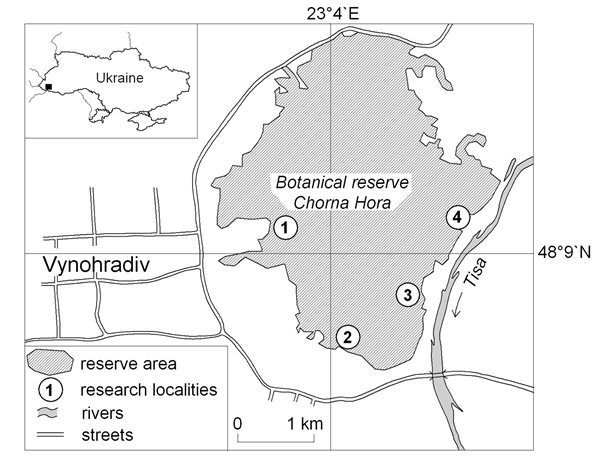
The geological formations of the Chorna Hora are dominated by andesites, liparites and tuff, which emerge here and there on its slopes as rocky outcrops. The surface of the mountain is covered in brown earths of varying thickness. From its foot at an altitude of ca 120 m there spreads an extensive plain, covered with different types of soil depending on the substrate: chernozems, alluvial soils and brown earths.
The area’s climate resembles that of the warm parts of the Pannonian Plain. However, it differs fundamentally from that of other, adjacent parts of Transcarpathia in that it has the largest number of days with very warm, rainless weather compared with the Carpathian regions to the north. The microclimate of the Chorna Hora’s southern slopes is among the warmest in the whole of Ukraine. The mean annual air temperature is 9.9º C, the mean for January is 3º C and for July it is 21º C. Annual precipitation is ca 750 mm (GERENCZUK, 1981).
This specific combination of geology and climate has produced a highly characteristic, largely stenotopic vegetation found nowhere else in Ukraine. Very interesting and diverse xerothermic forest steppe communities grow on the strongly insolated south and south-east facing slopes of the Chorna Hora (Figs. 3, 4); similarly fascinating are the xerothermic swards growing on the steep sides of the numerous rocky outcrops (Figs. 5, 6, 7). In addition, much of this mountain is covered by oakhornbeam, oak and beech woodland, while there are riparian woodlands on the banks of the Tisa. The Transcarpathian Plain, which surrounds the mountain, is mostly treeless; much of it is farmed. The plant associations of this area can be ordered in accordance with their habitat requirements. Starting with the wettest habitats, they are:
Communities of emergent vegetation growing mainly around ponds and drainage channels in the immediate neighbourhood of the south-western slopes of the Chorna Hora.
Mown meadow communities with a large proportion of herbaceous vegetation, lying mostly in the broad valley of the Tisa, some distance to the south of the Chorna Hora.
Communities of riparian woodland and willow scrub, abundant on the moist soils of the Tisa valley, periodically inundated when water levels in the river are high.
Broad-leaved woodland communities of the class Querco-Fagetea, which cover large swathes of the Chorna Hora’s slopes, particularly those with an easterly, northerly and westerly exposure. They mostly take the form of oak-hornbeam, oak or mixed woodlands.
Farmland communities of the classes Secalietea and Chenopodietea, as well as wasteland communities of the classes Artemisietea, Plantaginetea and Epilobietea angustifolii, patches of which are found around human habitations, roadsides and felled areas in woodland.
Xerothermic sward communities on the steep slopes and rocky outcrops exposed to the south, south-west and south-east.
Forest steppe communities growing on gentler slopes exposed to the south, south-west and south-east.
Noctuid moths were systematically trapped at four localities (Fig. 1): Chorna Hora 1: situated on the strongly insolated, south-western slope of the mountain with large numbers of rocky fragments strewn over the ground. The immediate environment consists of forest steppe with numerous patches of xerothermic rock sward rich in herbaceous plants.
Chorna Hora 2: situated on the southern slope of the mountain, mostly covered with transformed ecosystems consisting of allotment gardens in the form of small vineyards and orchards. In this environment, above the cliff of a disused quarry, there are small patches of xerothermic rock sward and forest steppe.
Chona Hora 3: situated on the south-eastern slope of the Chorna Hora. Much of this locality consists of a precipitous slope dropping down to the Tisa valley, and in places, the cliff-like walls of disused quarries. In the immediate vicinity there are xerothermic rock swards, while above there is forest steppe. Down in the Tisa valley there are riparian woodlands and willow scrub.
Chorna Hora 4: situated on the eastern slope of the mountain, at the foot of which there are transformed ecosystems consisting of recreational/allotment gardens with fruit trees. Immediately adjacent are meadow communities covering the gentler slopes of the Chorna Hora and deciduous woodland. A short distance away there are xerothermic rock sward and forest steppe environments on the precipitous rocky slopes, and communities of riparian woodland and willow scrub in the Tisa valley.
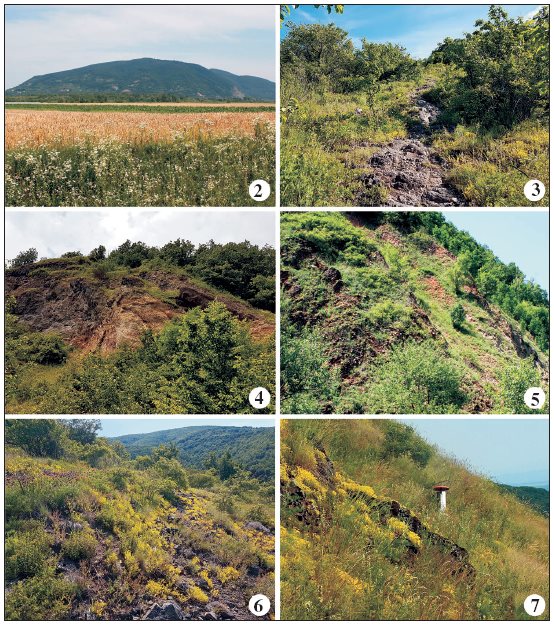
Research Methods
Noctuid moths were caught in these localities from 2009 until 2017. Because of the diversity of habitats there, they were trapped with a variety of techniques, though mainly using light traps. Moths were attracted at night to a Skinner trap equipped with a 250 W mercury vapour bulb, and to 500 W bulbs of the same kind, powered by a portable generator, illuminating a white screen. Moreover, in 2016 and 2017, moths were caught using a number of portable traps equipped with black lights (TL 6W/08 - Philips) (Fig. 7), which were deployed each night in many different ecosystems. Moths were also attracted to wine ropes, i.e. lengths of thick string soaked in fruit juice mixed with wine, which were then hung on tree branches and bushes in the various plant communities, well away from any light sources. Finally, in the evenings, moths were netted on sight from flowering plants.
From the research material we were able to establish the total number of species for each locality and to identify stenotopic species occurring only in xerothermic rock sward and forest steppe communities. In order to define the similarity and the degree of transformation of these xerothermic ecosystems, similarity indices were calculated using Jaccard’s formula (KREBS, 2001) and compared on the basis of characteristic species:

where j - the number of characteristic species occurring at both localities, a, b - the number of characteristic species occurring at each locality.
The Shannon-Wiener biological diversity indices H’ (KREBS, 2001) were also calculated and compared for the species characteristic of a particular locality:

where pi stands for the proportion of the i-th species in the assemblage.
Results
Our survey on the Chorna Hora mountain in Transcarpathia (Ukraine) yielded a total of 299 species of moth from the families Erebidae, Nolidae and Noctuidae. If we add a further 10 species, recorded in this area by GERYAK (2010), that we failed to record during our survey, the number of species from the Chorna Hora rises to 309. Table 1 lists all the noctuid species recorded in the study area in accordance with the systematic arrangement of KARSHOLT & NIEUKERKEN (2013).
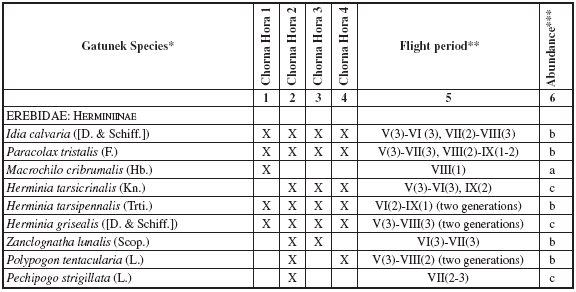
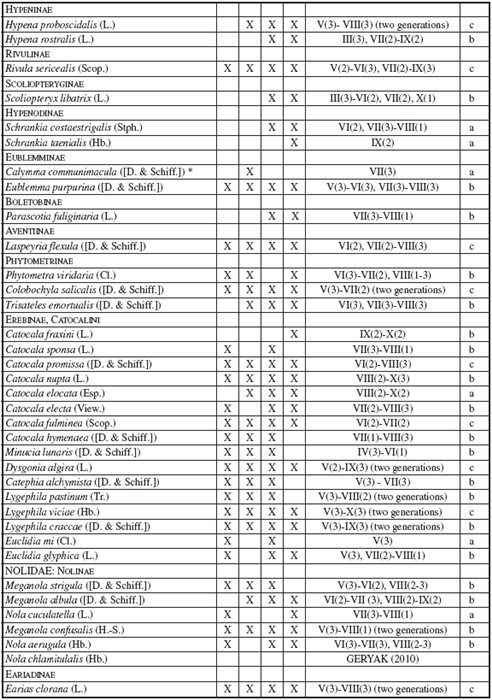
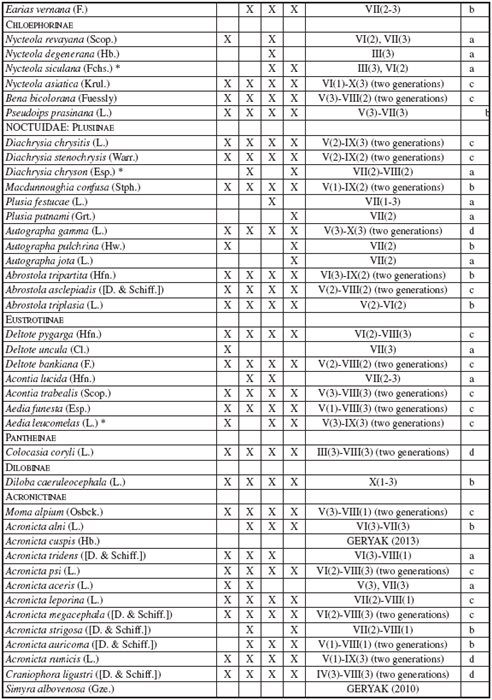
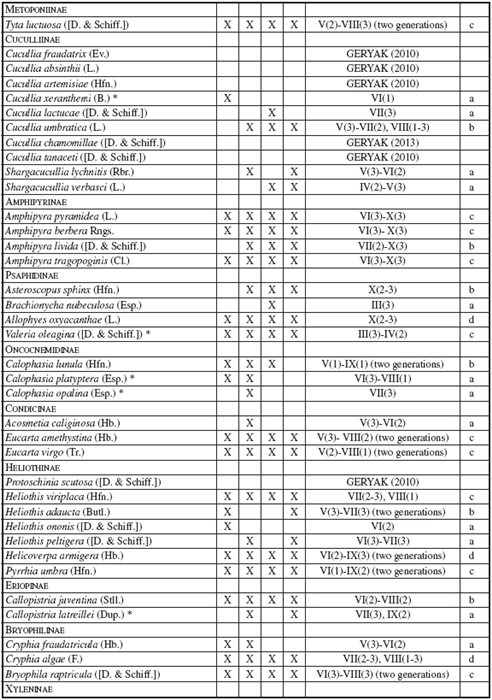
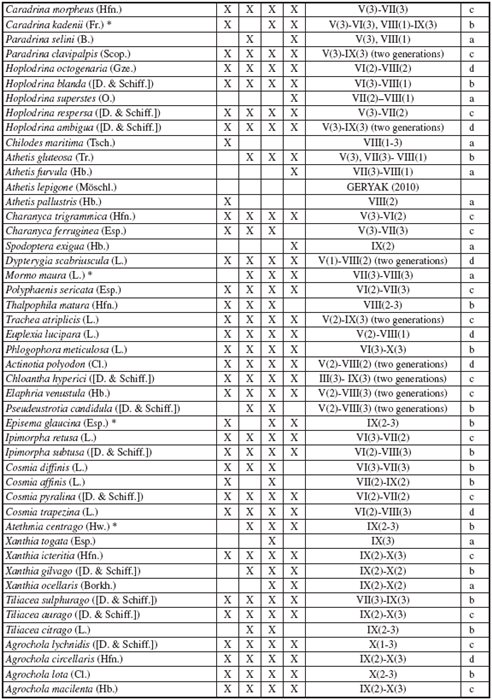
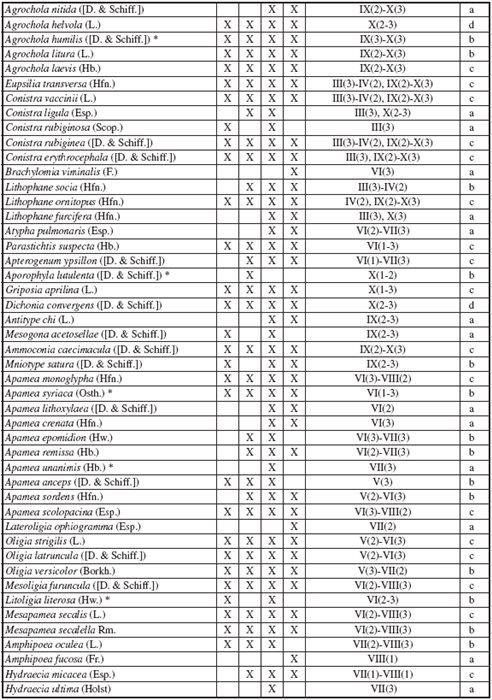
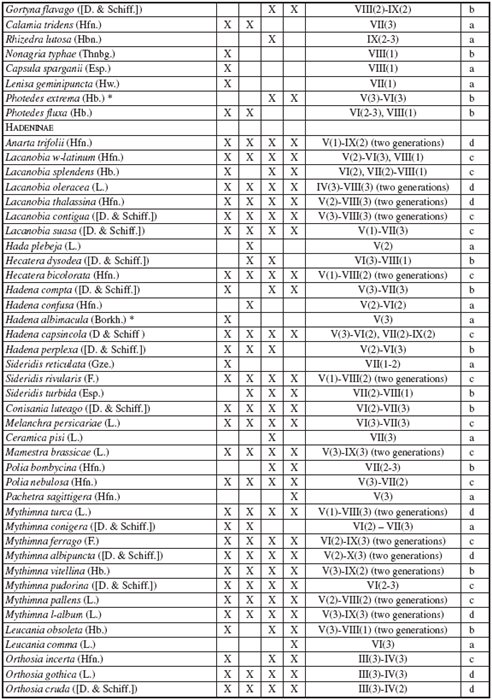
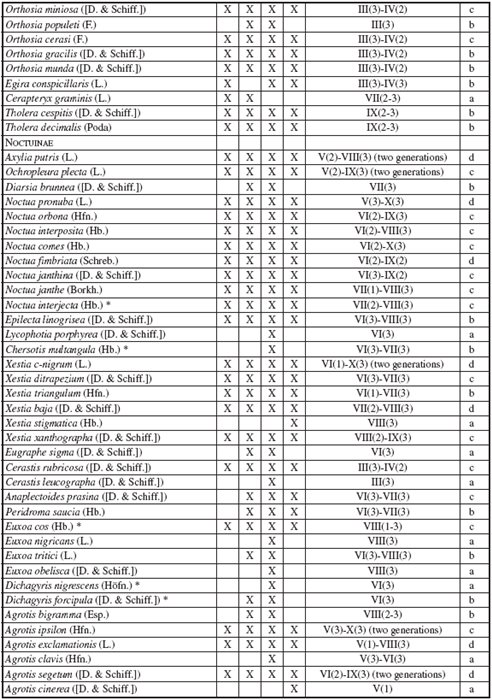
Faunistic Analysis
Ninety-six of the noctuid species recorded during this survey were new to the Chorna Hora. Also, worth noting is the discovery of two species new to Ukraine - C. platyptera and C. latreillei (NOWACKI et al., 2010) - and 17 new to Transcarpathia. Among those noctuids occurring in the ecosystems unique to the Chorna Hora are species that are faunistically valuable in both Ukraine and Europe as a whole. They are mostly stenotopic species that are rare or local in Ukraine. Forty-two such species were recorded on the Chorna Hora, i.e. 14% of the overall number of noctuids found in the survey area. They are: I. calvaria, M. cribrumalis, S. costaestrigalis, S. taenialis, C. communimacula, D. algira, N. siculana, D. chryson, A. leucomelas, C. xeranthemi, V. oleagina, C. platyptera, C. opalina, A. caliginosa, H. ononis, C. latreillei, C. kadenii, H. superstes, H. respersa, A. gluteosa, M. maura, P. sericata, E. glaucina, A. centrago, T. sulphurago, A. humilis, A. lutulenta, D. convergens, M. acetosellae, A. syriaca, A. unanimis, L. literosa, H. ultima, P. extrema, H. albimacula, N. interjecta, E. linogrisea, L. porphyrea, C. multangula, E. cos, D. nigrescens and D. forcipula. The following of these species are deserving of special mention.
Calymma communimacula ([D. & Schiff.])
Locality 2: 28-VII-2009, 3 exx., trapped at light in a xerothermic sward environment that has become waste ground.
A Ponto-Mediterranean species, local in south-central Europe (NOWACKI, 1998). Very rare in Ukraine, with records at just single localities in the eastern, southern and central parts of the country (KLYUCHKO et al., 2001). New to Transcarpathia (NOWACKI et al., 2010).
Nycteola siculana (Fchs.)
Locality 3: 28-III-2017, 1 ex., locality 4: 13-VI-2013, 1 ex., trapped at light in a scrubby environment in the Tisa valley.
A European species, local in southern, western and central Europe (NOWACKI, 1998). Not recorded in Ukraine before the 21st century; very rare, with records of just single specimens, mostly in Transcarpathia (GERYAK et al., 2014).
Diachrysia chryson (Esp.)
Locality 2: 12-VIII-2009, 1 ex., locality 4: 12-VII-2010, 1 ex., trapped at light in scrubby habitats.
A Euroasiatic species, local in central Europe (NOWACKI, 1998). Rare in Ukraine; only records of single specimens, mainly from the Carpathian Mts. and Transcarpathia (KLYUCHKO et al., 2001; GERYAK 2010).
Aedia leucomelas (L.)
Locality 1: 3-VIII-2010, 3 exx., 22-VIII-2010, 2 exx., locality 3: 23-VI-2009, 5 exx., 20-VI-2017, 6 exx., 23-IX-2017, 3 exx., locality 4: 22-VI-2009, 3 exx., 23-VI-2009, 8 exx., 12-VII-2010, 7 exx., 15- IX-2009, 4 exx., 2-5-VIII-2016, 7 exx., caught at light in scrubby forest steppe and xerothermic sward environments.
A Palaeotropical-Eurasiatic species, local in central Europe to the south of the Alps, Sudetens and Carpathians (NOWACKI, 1998). Very rare in Ukraine: hitherto recorded only in Crimea (KLYUCHKO et al., 2001) and at a few localities in Transcarpathia (GERYAK, 2010; NOWACKI, 2009)
Cucullia xeranthemi (B.)
Locality 1: 5-VI-2010, 1 ex., trapped at light in a xerothermic sward habitat.
A Ponto-Turkestanian species, local in central Europe to the south of the Alps, Sudetens and Carpathians (NOWACKI, 1998). Very rare in Ukraine: records to date only from the east of the country (KLYUCHKO et al., 2001) and a few new localities in Transcarpathia and western Ukraine (GERYAK,2010).
Valeria oleagina ([D. & Schiff.])
Locality 1: 29-III-2017, 14 exx., locality 2: 30-III-2017, 3 exx., locality 3: 28-III-2017, 17 exx., trapped at light in scrubby forest steppe and xerothermic sward environments.
A Ponto-Mediterranean species, local in central Europe to the south of the Alps, Sudetens and Carpathians (NOWACKI, 1998). Very rare in Ukraine: for a long time, its only known locality was near Lviv (GARBOWSKI, 1892). The first Ukrainian record for more than 100 years, a new one for Transcarpathia, comes from Dovhe and Khust (NOWACKI & BIDYCZAK, 2009). In recent years trapped at a few other localities in Transcarpathia (GERYAK, 2010).
Calophasia platyptera (Esp.)
Locality 1: 21-VI-2017, 1 ex., locality 2: 3-VIII-2016, 1 ex., trapped at light in a xerothermic sward habitat.
A Ponto-Mediterranean species, local in south-central Europe to the south of the Alps, Sudetens and Carpathians, and also on the Pannonian Plain (NOWACKI, 1998; VARGA et al., 2005). New to Ukrainian Transcarpathia.
Calophasia opalina (Esp.)
Locality 2: 21-VII-2017, 1 ex., trapped at light in a xerothermic sward habitat.
A Ponto-Mediterranean-Turkestanian species, local in south-central Europe to the south of the Alps, Sudetens and Carpathians; also, on the Pannonian Plain (NOWACKI, 1998; VARGA et al., 2005). In Ukraine, local and rare at a number of localities in eastern parts of the country (KLYUCHKO et al., 2001). New to Transcarpathia
Heliothis ononis ([D. & Schiff.])
Locality 1: 13-VI-2010, 1 ex., trapped at light in a xerothermic sward habitat.
A Holarctic species, occurring in the steppe zone of Europe, with a range extending as far west as Austria, Switzerland and France (NOWACKI, 1998). Local and rare in Ukraine: records from single localities all over the country (KLYUCHKO et al., 2001). New to Transcarpathia.
Callopistria latreillei (Dup.)
Locality 2: 28-VII-2009, 1 ex, locality 4: 16-IX-2009, 1 ex., trapped at light in scrubby forest steppe and xerothermic sward environments.
A Ponto-Mediterranean species, occurring only in south-central Europe in Austria, Hungary and Romania (NOWACKI, 1998; RAKOSY, 1997; VARGA et al., 2005). The present records from Transcarpathia are also the first for Ukraine (NOWACKI et al., 2010).
Caradrina kadenii (Fr.)
Locality 1: 21-VI-2017, 3 exx., 4-VIII-2016, 2 ex., locality 3: 3-VIII-2016, 3 exx., 28-V-2017, 1 ex. 20-VI-2017, 4 exx., 21-VII-2017, 1 ex., 23-IX-2017, 2 exx., locality 4: 22-VI-2009, 1 ex., 13-VI-2013, 3 ex., 5-VIII-2016, 2 ex., trapped at light in scrubby forest steppe and xerothermic sward environments.
A Ponto-Mediterranean species, local in south-central Europe to the south of the Alps, Sudetens and Carpathians; also, on the Pannonian Plain (NOWACKI, 1998; VARGA et al., 2005). Local and rare in Ukraine: records from just single localities, mainly in eastern parts of the country (KLYUCHKO et al., 2001). New to Transcarpathia (NOWACKI & BIDYCZAK, 2009).
Mormo maura (L.)
Locality 2: 25-VII-2017, 1 ex., locality 3: 21-VIII-2017, 2 exx., locality 4: 20-VIII-2017, 1 ex., trapped on wine ropes deployed by the banks of the River Tisa, and also at light in scrubby forest steppe.
A Ponto-Mediterranean species, local in central Europe (NOWACKI, 1998). Local and rare in Ukraine: records from single localities, mainly in Crimea and the Roztocze Upland (KLYUCHKO et al., 2001). Recent records from a few other localities in Transcarpathia (GERYAK, 2010).
Polyphaenis sericata (Esp.)
Locality 1: 28-VI-2010, 2 exx., 5-VII-2010, 4 exx., 21-VI-2017, 6 exx., locality 2: 21-VI-2017, 3 exx., locality 3: 23-VI-2009, 3 exx., 13-VII-2010 3 exx., 20-VI-2017, 6 exx., locality 4: 22-VI-2009, 3 exx., 23-VI-2009, 5 exx., 26-VI-2009, 4 exx., 12-VII-2010 14 exx., trapped at light in scrubby forest steppe and xerothermic sward environments.
A Ponto-Mediterranean species, local in south-central Europe to the south of the Alps, Sudetens and Carpathians (NOWACKI, 1998). Earlier Ukrainian records only from Crimea and the Odessa region (KLYUCHKO et al., 2001; KLYUCHKO, 2006). The present survey revealed this species as new to Transcarpathia (NOWACKI & BIDYCZAK, 2009); also confirmed at many other localities inthis region (GERYAK, 2010).
Episema glaucina (Esp.)
Locality 1: 22-IX-2017, 2 exx., locality 3: 23-25-IX-2017, 7 exx., locality 4: 16-IX-2009, 2 exx., trapped at light in forest steppe and xerothermic sward environments.
A Ponto-Mediterranean species, local in south-central Europe to the south of the Alps, Sudetens and Carpathians; also, on the Pannonian Plain (NOWACKI, 1998; VARGA et al., 2005). Local and rare in Ukraine at single localities, mainly in eastern parts of the country and in Crimea (KLYUCHKO et al., 2001). New to Transcarpathia (NOWACKI & BIDYCZAK, 2009).
Atethmia centrago (Hw.)
Locality 2: 25-IX-2017 1 ex., locality 3: 23-25-IX-2017, 3 exx., locality 4: 16-IX-2009, 4 exx., trapped at light in scrubby forest steppe and xerothermic sward environments.
A Holo-Mediterranean-Turkestanian species, local in central Europe (NOWACKI, 1998). Local and rare in Ukraine at single localities, mainly in eastern parts of the country and in Crimea (KLYUCHKO et al., 2001). The earlier record for Transcarpathia from the Berehov area was the first for this region (GERYAK, 2010).
Agrochola humilis ([D. & Schiff.])
Locality 1: 20-X-2016, 2 exx., locality 2: 10-X-2009 1 ex., locality 3: 19-21-X-2016, 3 exx., locality 4: 10-14-X-2010, 3 exx., trapped at light in forest steppe and xerothermic sward environments.
A Ponto-Mediterranean species, local in south-central Europe to the south of the Alps, Sudetens and Carpathians; also, on the Pannonian Plain (NOWACKI, 1998, VARGA et al., 2005). Local and rare in Ukraine at single localities in Crimea (KLYUCHKO et al., 2001). Recent records from a few other localities in Transcarpathia (GERYAK, 2010).
Aporophyla lutulenta ([D. & Schiff.])
Locality 2: 10-X-2009, 2 exx., trapped at light in scrubby forest steppe environments.
A Ponto-Mediterranean species, local in south- and east-central Europe to the south of the Alps, Sudetens and Carpathians (NOWACKI, 1998). Local and rare in Ukraine at single localities in Crimea (KLYUCHKO et al., 2001). Recently recorded at a few other localities in Transcarpathia (GERYAK, 2010).
Apamea syriaca (Osth.)
Locality 1: 5-VI-2010, 2 exx., 21-VI-2017, 3 exx., locality 2: 16-VI-2009, 1 ex., 22-VI-2009, 2 exx., 21-VI-2017, 3 exx., locality 3: 23-VI-2009, 1 ex., 20-VI-2017, 6 exx., locality locality 4: 23-VI- 2009, 3 exx., 20-VI-2017, 3 exx., trapped at light in scrubby forest steppe and xerothermic sward environments.
A Ponto-Mediterranean species, local in south-central Europe (NOWACKI, 1998). Local and rare in Ukraine at single localities in eastern parts of the country and in Crimea (KLYUCHKO et al., 2001). New to Transcarpathia (NOWACKI & BIDYCZAK, 2009); confirmed at many other localities in this region (GERYAK, 2010).
Apamea unanimis (Hb.)
Locality 3: 21-VII-2017, 1 ex., trapped at light in riparian woodland in the Tisa valley.
A Eurasiatic species occurring throughout central Europe (NOWACKI, 1998). Local and rare in Ukraine at single localities, mainly in western parts of the country, including Transcarpathia (GERYAK, 2010; KLYUCHKO et al., 2001).
Litoligia literosa (Hw.)
Locality 1: 17-VI-2010, 1 ex., 23-VI-2010, 2 exx., locality 3: 26-VI-2009, 2 exx., 20-VI-2017, 3 exx., trapped at light in scrubby forest steppe and xerothermic sward environments.
A Eurasiatic species occurring throughout central Europe (NOWACKI, 1998). Local and rare in Ukraine, recorded at single localities all over the country (KLYUCHKO et al., 2001).
This survey revealed it as new to Transcarpathia.
Photedes extrema (Hb.)
Locality 3: 29-V-2017, 2 ex., 4: 23-VI-2009, 1 ex., 13-VI-2013, 5 exx., trapped at light in scrubby forest steppe and xerothermic sward environments.
A Eurasiatic species occurring throughout central Europe (NOWACKI, 1998). Very rare, first recorded in Ukraine only recently. Known only from Belgorod Dnestrovskiy near Odessa (KLYUCHKO et al., 2004) and the Desnjano-Starogytskiy National Park (KLYUCHKO et al., 2004a). This survey showed it to be new to Transcarpathia (NOWACKI & BIDYCZAK, 2009); confirmed at many other localities in this region (GERYAK, 2010).
Hadena albimacula (Borkh.)
Locality 1: 30-V-2017, 1 ex., trapped at light in a scrubby forest steppe and xerothermic sward environment.
A Eurasiatic species, local throughout central Europe (NOWACKI, 1998). Local and rare in Ukraine, records from single localities all over the country (KLYUCHKO et al., 2001). The earlier record for Transcarpathia from the Berehov area was the first for this region (GERYAK, 2010).
Noctua interjecta (Hb.)
Locality 1: 4-VIII-2016, 3 exx., 25-VII-2017, 2 exx., locality 2: 26-VII-2017, 4 exx., locality 3: 3- 5-VIII-2016, 11 exx., 24-26-VII-2017, 9 exx., locality 4: 12-VII-2010, 2 exx., 2-5-VIII-2016, 12 exx., trapped at light in scrubby forest steppe and xerothermic sward environments.
An Atlantic-Mediterranean species occurring locally in the southern and eastern parts of central Europe as the subspecies Noctua interjecta (Hb.), which is rapidly expanding its range north-westwards (BÁLINT et al., 2016). No records in Ukraine before the end of the 20th century (KLYUCHKO et al., 2001). Earlier Transcarpathian records only from the Luh nad Tisa area near Rakhiv were the first for this region (GERYAK, 2010).
Chersotis multangula (Hb.)
Locality 3: 23-VI-2009, 1 ex., 13-VII-2010, 2 exx., 20-23-VI-2017, 16 exx., trapped at light in xerothermic sward habitats and in scrubby forest steppe, mostly lying above the Tisa valley.
A Holo-Mediterranean-Iranian species, local in south-central Europe, mainly to the south of the Alps, Sudetens and Carpathians (NOWACKI, 1998). Local and very rare in Ukraine at single localities in the eastern part of the country in Crimea and in the west in the Dniestr valley (KLYUCHKO et al., 2001). New to Transcarpathia (NOWACKI & BIDYCZAK, 2009).
Euxoa cos (Hb.)
Locality 1: 19-VIII-2017, 7 exx., locality 2: 19-VIII-2017, 5 exx., locality 3: 4-VIII-2016, 1 ex., 24-28-VIII-2016, 25 exx., 18-20-VIII-2017, 35 exx., locality 4: 20-VIII-2017, 8 exx., trapped at light in xerothermic sward habitats and in scrubby forest steppe. This species was in fact recorded at all four localities, and its Chorna Hora population is very numerous.
A Ponto-Mediterranean species, very local and rare in south-central Europe only to the south of the Alps, Sudetens and Carpathians (RAKOSY, 1997). Recently recorded at Ortelec in the Sãlaj region of Romania (BÁLINT et al., 2016). Previous records from Ukraine showed it to be very rare at single localities only in Crimea (KLYUCHKO et al., 2001). New to Transcarpathia. This is the northernmost known locality of this species.
Dichagyris nigrescens (Höfn.)
Locality 3: 20-VI-2017, 3 exx., trapped at light in xerothermic sward habitats on the upper slopes of the Chorna Hora.
A Ponto-Mediterranean species, very local and rare in south-central Europe only to the south of the Alps, Sudetens and Carpathians (NOWACKI, 1998). Early 20th century records from Ukraine showed it to be very rare at single localities only in the western part of the country in the Podole region in the Dniestr valley (KLYUCHKO et al., 2001). A species new to Transcarpathia.
Dichagyris forcipula ([D. & Schiff.])
Locality 2: 21-VI-2017, 2 exx., locality 3: 20-23-VI-2017, 17 exx., trapped at light in xerothermic sward habitats mainly on the upper slopes of the Chorna Hora.
A Ponto-Mediterranean species, very local and rare in south-central Europe only to the south of the Alps, Sudetens and Carpathians (NOWACKI, 1998). Local and very rare in Ukraine at single localities, mainly in the eastern part of the country in Crimea and in the west in the Dniestr valley (KLYUCHKO et al., 2001). New to Transcarpathia.}
Ecological Analysis
Carried out in the Chorna Hora Botanical Reserve in Ukrainian Transcarpathia, this survey yielded a total of 299 species of noctuids, trapped in various numbers at the four localities (Table 1). It is important to note that the number of species found in each assemblage is not a direct indicator of the biodiversity or even the natural value of these ecosystems. In line with our research hypothesis, the presence of species unique to xerothermic sward and forest steppe ecosystems is of far greater significance and much more meaningful: this is why the Chorna Hora is such a high-ranking European refuge for xerothermic noctuid moths. Our survey yielded 32 such species from the whole of the study area, which were trapped in various numbers at the four localities (Table 2).
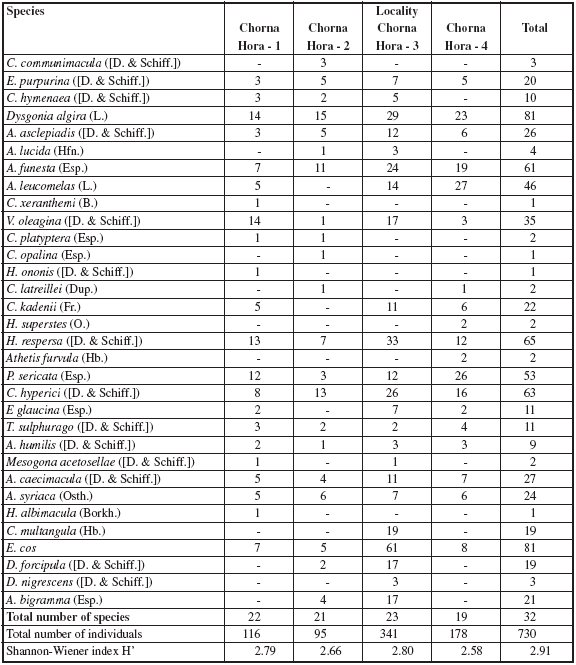
As regards the number of species unique to the xerothermic sward and forest steppe ecosystems on the Chorna Hora, the most typical of our trapping localities was No. 3, where 23 species of this group were trapped. Comparative analysis of the number of species and Jaccard’s similarity indices of characteristic species (see Table 3) among the various assemblages of Noctuoidea at the four localities enabled the order of localities with similar values of these indices to be established.

The closest as regards similarity is locality Chorna Hora-1 (similarity index 66.7 and 22 characteristic species); the next in order are Chorna Hora-2 (similarity index 63.0 and 21 characteristic species) and Chorna Hora-4 (similarity index 61.5 and 19 characteristic species) (Tables 2, 3).
Similar results were obtained from a comparison of the biodiversity of xerothermic noctuids occurring at the four localities using the Shannon-Wiener biodiversity index H’. If this index for the entire assemblage of xerothermic noctuids in the Chorna Hora Botanical Reserve took a value of 2.91, then for the various trapping localities, the assemblage at Chorna Hora-3 took the highest value of H’ = 2.80; the other values in decreasing order were Chorna Hora-1 (H’ = 2.79), Chorna Hora-2 ( H’ = 2.66) and Chorna Hora-4 (H’ = 2.58).
Summary of Results
Large, natural xerothermic rock sward and forest steppe ecosystems are unique in central Europe. Human activities have already substantially transformed the majority of such habitats. This survey (2009-2017) of the Noctuoidea of the xerothermic ecosystems on the slopes of the Chorna Hora mountain in Ukrainian Transcarpathia, an isolated enclave of the Carpathian Biosphere Reserve, has enabled a good many species of these moths to be added to the local faunistic checklist.
We recorded a total of 299 noctuid species on the Chorna Hora. If we include another 10 species found earlier by GERYAK (2010), this number rises to 309 - 46% of all noctuids ever recorded in Ukraine. The number of species recorded during the present survey is by no means final. This is suggested by the many interesting ecosystems that are found on the slopes of the Chorna Hora and the species richness of this group of moths in adjacent areas of western Ukraine. For comparison, a total of 414 species of noctuids have been recorded from the whole of Transcarpathia (GERYAK, 2010; GERYAK, 2013; KLYUCHKO, 2006; NOWACKI & BIDYCZAK, 2009, NOWACKI et al., 2010). It should be borne in mind that this number relates to all the ecosystems in Transcarpathia and includes a good number of species that are found only in montane ecosystems, including alpine species. The present survey revealed 96 species new to the Chorna Hora; it also yielded two species new to Ukraine and 17 new to Transcarpathia.
Analysis of the research material enabled this noctuid fauna to be characterised with respect to its assemblages in the various plant communities in the Chorna Hora reserve. In line with our research hypothesis, we paid special attention to the noctuid species composition of the xerothermic habitats: these consist mainly of xerothermic sward communities on the steep slopes and rocky outcrops and of forest steppe communities covering the gentler slopes exposed to the south, southwest and south-east. Qualitative analysis shows that these ecosystems support the largest number of stenotopic species, some of which are of great faunistic value. Thirty-three of the noctuid species recorded on the Chorna Hora can be classified as xerothermic specialists: most of them occur in highly specific, usually natural ecosystems.
In conclusion, we can state that our survey has shown the Chorna Hora mountain in Ukrainian Transcarpathia, with its numerous xerothermic sward and forest steppe ecosystems, is an important refuge for xerothermic noctuids and is of prime significance for the conservation of the biodiversity of Ukraine in particular and Europe in general.
Acknowledgements
Here we would like to extend our cordial gratitude to everyone, whose disinterested contributions helped us in various ways to produce this paper. We thank Prof. Dr Vitaliy P. Fedorenko for inviting us to conduct this survey in Transcarpathia and the Management of the “Carpathian Biosphere Reserve” for permission to carry out research in the Chorna Hora Botanical Reserve. A word of thanks must also go to those people who helped to organise and carry out the fieldwork by participating in the acquisition of the research material, namely, Marek Bunalski, Roman Bidychak, Jaroslaw Iwaniszyniec, Krzysztof Palka and Pawel Sienkiewicz. Special thanks are due to Peter Senn for translating the Polish parts and editing the English parts of the manuscript.
BIBLIOGRAPHY
BÁLINT, Z., KATONA, G. & RONKAY, L., 2016.– Data to the knowledge of the Macrolepidoptera fauna of the Sa˘ laj-region, Transylwania, Romania (Arthropoda: Insecta).– Studia Universitatis “Vasile Goldis”, Seria Stiintele Vietii, 26 Supplement, 1: 59-74.
GARBOWSKI, T., 1892.– Materialen zu einer Lepidopterenfauna Galiziens, nebst systematischen und biologischen Beiträgen.– Sitzungsbrichte der Akademie der Wissenschasften. Mathematisch- Naturwissenschaftliche Classe. Wien., 150: 869-1004.
GERENCZUK, K. I., 1981.– Pruroda Zakarpatskoji oblasti. Lviv. Vushcha Shkola: 156 pp. (in Ukrainian).
GERYAK Yu., 2010.– The Noctuoidea (Insecta, Lepidoptera) of the Transcarpatian region.– Naukovuj Visnuk Yzhorodskiogo Universytetu, Seria Biologia, 29: 126-139. (in Ukrainian).
GERYAK Yu., 2013.– To the fauna of Noctuoidea (Lepidoptera, Insecta) of the Ukrainian Carpathians.– Scientific Bulletin of the Uzhgorod University (Series: Biology), 35: 73-83. (in Ukrainian).
GERYAK Yu., ZHAKOV A., KOSTJUK I. & SERGIENKO V., 2014.– Ecological faunistic review of Nolidae (Noctuoidea, Lepidoptera) of Ukraine.– Proceedings of the National Museum of Natural History. Kiev, 12: 71-99. (in Ukrainian).
KARSHOLT, O. & NIEUKERKEN, E. J., 2013.– Lepidoptera, Moths. Fauna Europaea version 2.6.2. Available from http://www.faunaeur.org.
KLYUCHKO, Z., 1963.– Sowki zapadnykh oblastiej Ukrainy: 175 pp. (in Russian).
KLYUCHKO, Z., 2006.– Noctuid Moths of Ukraine: 248 pp. Kijev. (in Ukrainian).
KLYUCHKO, Z. F., BUDASHKIN, Yu. I. & GERASIMOV, R. P., 2004.– New and Little-Known Noctuidae (Lepidoptera, Noctuidae) from Ukraine.– Vestnik Zoologii, 38: 94. (in Russian).
KLYUCHKO, Z. F., MATOV, A. Yu. & SEVEROV, I. G., 2004a.– To the knowledge of owlet moths fauna (Lepidoptera: Noctuidae s. l.) of the northern Black Sea Region [Ukraine].– The Kharkov Entomological Society Gazette, 12: 147-154. (in Russian).
KLYUCHKO, Z. F., PLYUSHCH, I. G. & SHESHURAK, P. N., 2001.– Annotated catalogue of noctuids (Lepidoptera, Noctuidae) of the fauna of Ukraine: 884 pp. Institute of Zoology of National Academy of Sciences of Ukraine, Kiev. (in Russian).
KONDRACKI, J., 1989.– The Carpathians. Wydawnictwa Szkolne i Pedagogiczne. Warszawa (in Polish).
KREBS, C. J., 2001.– Ecology. The experimental analysis of distribution and abundance: 735 pp. Wydawnictwo Naukowe PWN, Warszawa. (in Polish).
NOWACKI, J., 1998.– The Noctuids (Lepidoptera, Noctuidae) of Central Europe: 143 pp. Bratislava.
NOWACKI, J. & BIDYCZAK, R., 2009.– Noctuid moths (Lepidoptera, Noctuidae) new and rare for the fauna of Zakarpatie, Ukraine.– Polish Journal of Entomology, 78: 319-322.
NOWACKI, J., BIDYCZAK, R. & PALKA, K., 2010.– Callopistria latreillei (Duponchel, 1827) new for Ukraine fauna and several rare species of owlets (Lepidoptera, Noctuidae).– Polish Journal of Entomology, 79: 77-80.
RAKOSY, L., 1997.– Die Noctuiden Rumäniens: 648 pp. Linz.
ROMANISZYN, J. & SCHILLE, F., 1929.– The Lepidopteran Fauna of Poland, 1- Prace monograficzne Komisji Fizjograficznej, 4: 552 pp. (in Polish).
VARGA, Z., RONKAY, L., BÁLINT, Z., GYULA, L., M. & PEREGOVITS, L., 2005.– Checklist of the fauna of Hungary. Macrolepidoptera, 3: 114 pp. Budapest.
Author notes
Autor para la correspondencia / Corresponding author